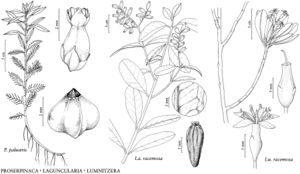Laguncularia
Suppl. Carp., 209, plate 217, fig. 3. 1807.
| Taxon | Illustrator ⠉ | |
|---|---|---|
 | Proserpinaca palustris Laguncularia racemosa Lumnitzera racemosa |
Shrubs or trees, often with ± erect pneumatophores. Stems erect, equal; twigs glabrous or sparsely hairy, hairs short, combretaceous. Leaves persistent, opposite and decussate; stipules absent; petiole not differentiated proximally and no part of it persistent, nectar glands conspicuous; blade fleshy-leathery, venation brochidodromous, apex obtuse, rounded, or retuse, surfaces often appearing glabrous, but with minute, scattered, salt-excreting glandular-hairs, these sunken and similar in form to domatial glands; with pit-domatia abaxially at junction of secondary and lower order veins, each containing a basal gland. Inflorescences terminal and axillary, spikes or panicles; bracteoles present. Flowers inconspicuous, bisexual or staminate on different plants; hypanthium shallowly cupulate, free portion 1.3–2.5 mm, densely pubescent abaxially; sepals 5, green, triangular, pubescent abaxially; petals 5, greenish white, orbiculate, 1–1.3 mm, apex rounded to obtuse, pubescent (especially marginally); stamens 10, ± included; nectary disc atop ovary, pubescent; ovary somewhat flattened; style straight, free from hypanthium, with well-developed pistillode in staminate flowers; ovules 2. Drupes slightly flattened, oblong to obovoid, slightly ridged; with 2 major ridges, those subtending bracteoles better developed than others and forming spongy wings; hypanthium and calyx persistent.
Distribution
s United States, e Mexico, West Indies, Central America, South America, w Africa, tropical and subtropical mangrove habitats
Discussion
Species 1.
Selected References
None.